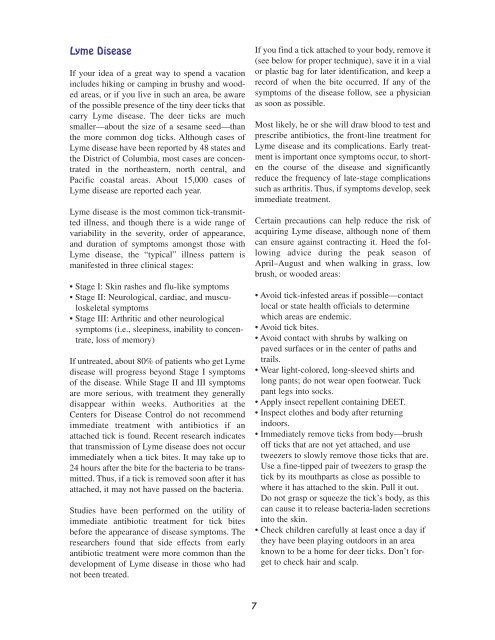View pdf - American Council on Science and Health
View pdf - American Council on Science and Health
View pdf - American Council on Science and Health
Create successful ePaper yourself
Turn your PDF publications into a flip-book with our unique Google optimized e-Paper software.
Lyme Disease<br />
If your idea of a great way to spend a vacati<strong>on</strong><br />
includes hiking or camping in brushy <strong>and</strong> wooded<br />
areas, or if you live in such an area, be aware<br />
of the possible presence of the tiny deer ticks that<br />
carry Lyme disease. The deer ticks are much<br />
smaller—about the size of a sesame seed—than<br />
the more comm<strong>on</strong> dog ticks. Although cases of<br />
Lyme disease have been reported by 48 states <strong>and</strong><br />
the District of Columbia, most cases are c<strong>on</strong>centrated<br />
in the northeastern, north central, <strong>and</strong><br />
Pacific coastal areas. About 15,000 cases of<br />
Lyme disease are reported each year.<br />
Lyme disease is the most comm<strong>on</strong> tick-transmitted<br />
illness, <strong>and</strong> though there is a wide range of<br />
variability in the severity, order of appearance,<br />
<strong>and</strong> durati<strong>on</strong> of symptoms am<strong>on</strong>gst those with<br />
Lyme disease, the “typical” illness pattern is<br />
manifested in three clinical stages:<br />
• Stage I: Skin rashes <strong>and</strong> flu-like symptoms<br />
• Stage II: Neurological, cardiac, <strong>and</strong> musculoskeletal<br />
symptoms<br />
• Stage III: Arthritic <strong>and</strong> other neurological<br />
symptoms (i.e., sleepiness, inability to c<strong>on</strong>centrate,<br />
loss of memory)<br />
If untreated, about 80% of patients who get Lyme<br />
disease will progress bey<strong>on</strong>d Stage I symptoms<br />
of the disease. While Stage II <strong>and</strong> III symptoms<br />
are more serious, with treatment they generally<br />
disappear within weeks. Authorities at the<br />
Centers for Disease C<strong>on</strong>trol do not recommend<br />
immediate treatment with antibiotics if an<br />
attached tick is found. Recent research indicates<br />
that transmissi<strong>on</strong> of Lyme disease does not occur<br />
immediately when a tick bites. It may take up to<br />
24 hours after the bite for the bacteria to be transmitted.<br />
Thus, if a tick is removed so<strong>on</strong> after it has<br />
attached, it may not have passed <strong>on</strong> the bacteria.<br />
Studies have been performed <strong>on</strong> the utility of<br />
immediate antibiotic treatment for tick bites<br />
before the appearance of disease symptoms. The<br />
researchers found that side effects from early<br />
antibiotic treatment were more comm<strong>on</strong> than the<br />
development of Lyme disease in those who had<br />
not been treated.<br />
If you find a tick attached to your body, remove it<br />
(see below for proper technique), save it in a vial<br />
or plastic bag for later identificati<strong>on</strong>, <strong>and</strong> keep a<br />
record of when the bite occurred. If any of the<br />
symptoms of the disease follow, see a physician<br />
as so<strong>on</strong> as possible.<br />
Most likely, he or she will draw blood to test <strong>and</strong><br />
prescribe antibiotics, the fr<strong>on</strong>t-line treatment for<br />
Lyme disease <strong>and</strong> its complicati<strong>on</strong>s. Early treatment<br />
is important <strong>on</strong>ce symptoms occur, to shorten<br />
the course of the disease <strong>and</strong> significantly<br />
reduce the frequency of late-stage complicati<strong>on</strong>s<br />
such as arthritis. Thus, if symptoms develop, seek<br />
immediate treatment.<br />
Certain precauti<strong>on</strong>s can help reduce the risk of<br />
acquiring Lyme disease, although n<strong>on</strong>e of them<br />
can ensure against c<strong>on</strong>tracting it. Heed the following<br />
advice during the peak seas<strong>on</strong> of<br />
April–August <strong>and</strong> when walking in grass, low<br />
brush, or wooded areas:<br />
• Avoid tick-infested areas if possible—c<strong>on</strong>tact<br />
local or state health officials to determine<br />
which areas are endemic.<br />
• Avoid tick bites.<br />
• Avoid c<strong>on</strong>tact with shrubs by walking <strong>on</strong><br />
paved surfaces or in the center of paths <strong>and</strong><br />
trails.<br />
• Wear light-colored, l<strong>on</strong>g-sleeved shirts <strong>and</strong><br />
l<strong>on</strong>g pants; do not wear open footwear. Tuck<br />
pant legs into socks.<br />
• Apply insect repellent c<strong>on</strong>taining DEET.<br />
• Inspect clothes <strong>and</strong> body after returning<br />
indoors.<br />
• Immediately remove ticks from body—brush<br />
off ticks that are not yet attached, <strong>and</strong> use<br />
tweezers to slowly remove those ticks that are.<br />
Use a fine-tipped pair of tweezers to grasp the<br />
tick by its mouthparts as close as possible to<br />
where it has attached to the skin. Pull it out.<br />
Do not grasp or squeeze the tick’s body, as this<br />
can cause it to release bacteria-laden secreti<strong>on</strong>s<br />
into the skin.<br />
• Check children carefully at least <strong>on</strong>ce a day if<br />
they have been playing outdoors in an area<br />
known to be a home for deer ticks. D<strong>on</strong>’t forget<br />
to check hair <strong>and</strong> scalp.<br />
7










